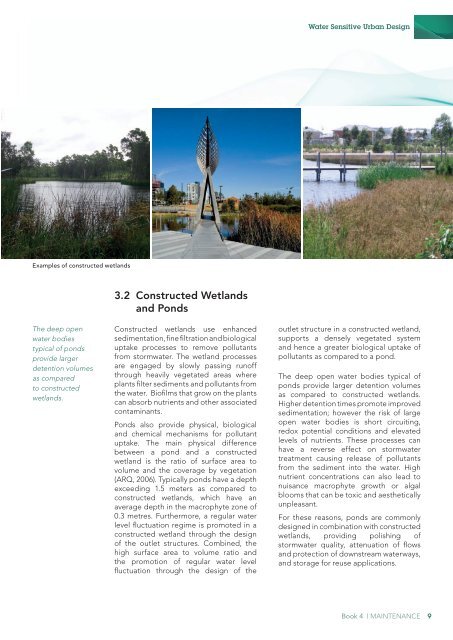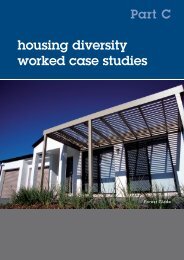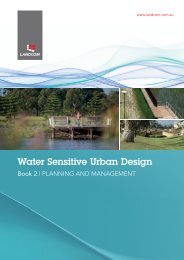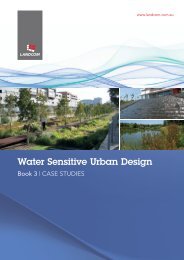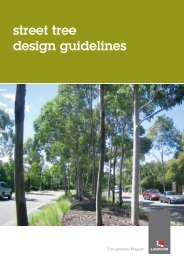Landcom Book 4 Maintenance - WSUD
Landcom Book 4 Maintenance - WSUD
Landcom Book 4 Maintenance - WSUD
You also want an ePaper? Increase the reach of your titles
YUMPU automatically turns print PDFs into web optimized ePapers that Google loves.
Water Sensitive Urban Design<br />
Examples of constructed wetlands<br />
3.2 Constructed Wetlands<br />
and Ponds<br />
The deep open<br />
water bodies<br />
typical of ponds<br />
provide larger<br />
detention volumes<br />
as compared<br />
to constructed<br />
wetlands.<br />
Constructed wetlands use enhanced<br />
sedimentation, fine filtration and biological<br />
uptake processes to remove pollutants<br />
from stormwater. The wetland processes<br />
are engaged by slowly passing runoff<br />
through heavily vegetated areas where<br />
plants filter sediments and pollutants from<br />
the water. Biofilms that grow on the plants<br />
can absorb nutrients and other associated<br />
contaminants.<br />
Ponds also provide physical, biological<br />
and chemical mechanisms for pollutant<br />
uptake. The main physical difference<br />
between a pond and a constructed<br />
wetland is the ratio of surface area to<br />
volume and the coverage by vegetation<br />
(ARQ, 2006). Typically ponds have a depth<br />
exceeding 1.5 meters as compared to<br />
constructed wetlands, which have an<br />
average depth in the macrophyte zone of<br />
0.3 metres. Furthermore, a regular water<br />
level fluctuation regime is promoted in a<br />
constructed wetland through the design<br />
of the outlet structures. Combined, the<br />
high surface area to volume ratio and<br />
the promotion of regular water level<br />
fluctuation through the design of the<br />
outlet structure in a constructed wetland,<br />
supports a densely vegetated system<br />
and hence a greater biological uptake of<br />
pollutants as compared to a pond.<br />
The deep open water bodies typical of<br />
ponds provide larger detention volumes<br />
as compared to constructed wetlands.<br />
Higher detention times promote improved<br />
sedimentation; however the risk of large<br />
open water bodies is short circuiting,<br />
redox potential conditions and elevated<br />
levels of nutrients. These processes can<br />
have a reverse effect on stormwater<br />
treatment causing release of pollutants<br />
from the sediment into the water. High<br />
nutrient concentrations can also lead to<br />
nuisance macrophyte growth or algal<br />
blooms that can be toxic and aesthetically<br />
unpleasant.<br />
For these reasons, ponds are commonly<br />
designed in combination with constructed<br />
wetlands, providing polishing of<br />
stormwater quality, attenuation of flows<br />
and protection of downstream waterways,<br />
and storage for reuse applications.<br />
<strong>Book</strong> 4 | MAINTENANCE 9


